German Bread (Authentic Vollkornbrot)
This post may contain affiliate links. See my disclosure policy.
A thoroughly authentic German Bread Recipe (Vollkornbrot)! This delicious traditional German whole grain seed bread is nutrient dense with a fabulous texture and positively packed with flavor. This makes a large loaf that freezes well so you can conveniently grab some whenever you’re in the mood.
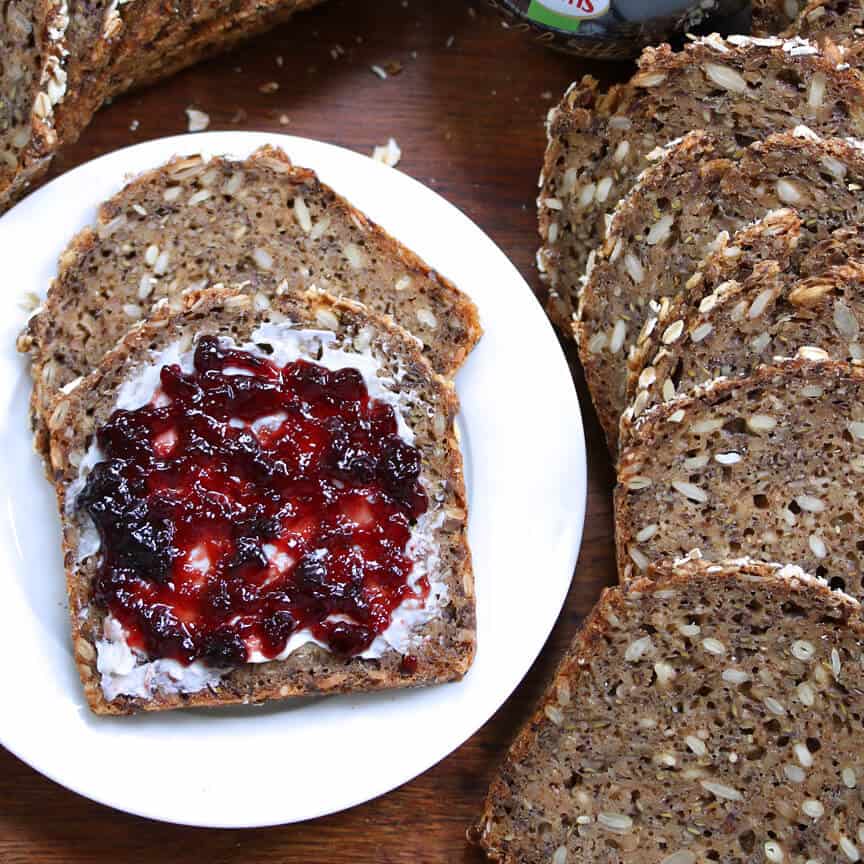
Authentic German Bread (Vollkornbrot)
Few things are better than a freshly baked loaf of bread slathered down with butter and some good jam. That’s true for crusty breads with fluffy interiors and the more hearty, dense breads that I also know and love from Europe. Here is a German bread that is beloved throughout Germany and is also widely enjoyed in Austria and Switzerland. It features a grain called Einkorn that is used throughout much of western Europe, but feel free to substitute other grains according to your preference.
Dense, chewy, packed with nutrition and full of flavor, this whole grain German brown bread (Vollkornbrot) is wonderful with your choice of butter, jam, Nutella, cheese, or cold cuts.
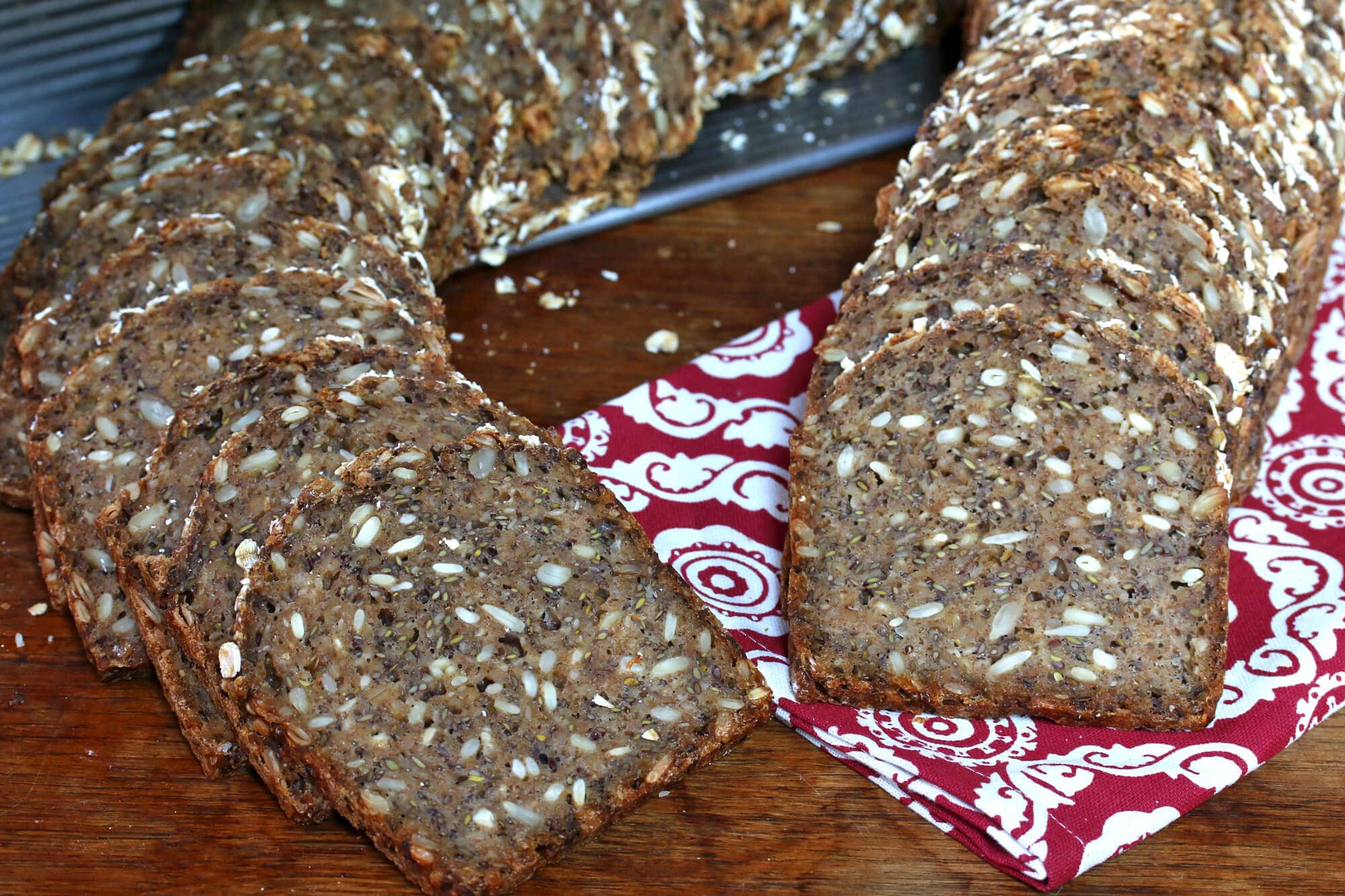
Have you heard of the grain einkorn before? Modern day wheat over the centuries has undergone a series of genetic changes for the purpose of increasing yield and gluten content. It’s almost unidentifiable compared to its ancestor (and my guess is that is why gluten issues are a more recent occurrence). Einkorn is the most ancient form of wheat on earth and hasn’t undergone these genetic changes. It is the purest form of wheat we have. You can purchase einkorn online HERE.
The advantages of einkorn: Most agree it tastes better than wheat and is much easier to digest, even easier than spelt. Compared to the gluten in modern day wheat, it contains a structurally different composition of gluten that the body is able to digest more easily. In fact, some people with gluten issues who have switched to einkorn have found that they’re able to tolerate and digest it with ease.
Even visually there’s a difference between wheat and einkorn. Though there are size variations within different types of wheat, generally most wheat (left) is longer in length than einkorn (right). Einkorn also has a deeper caramel color.
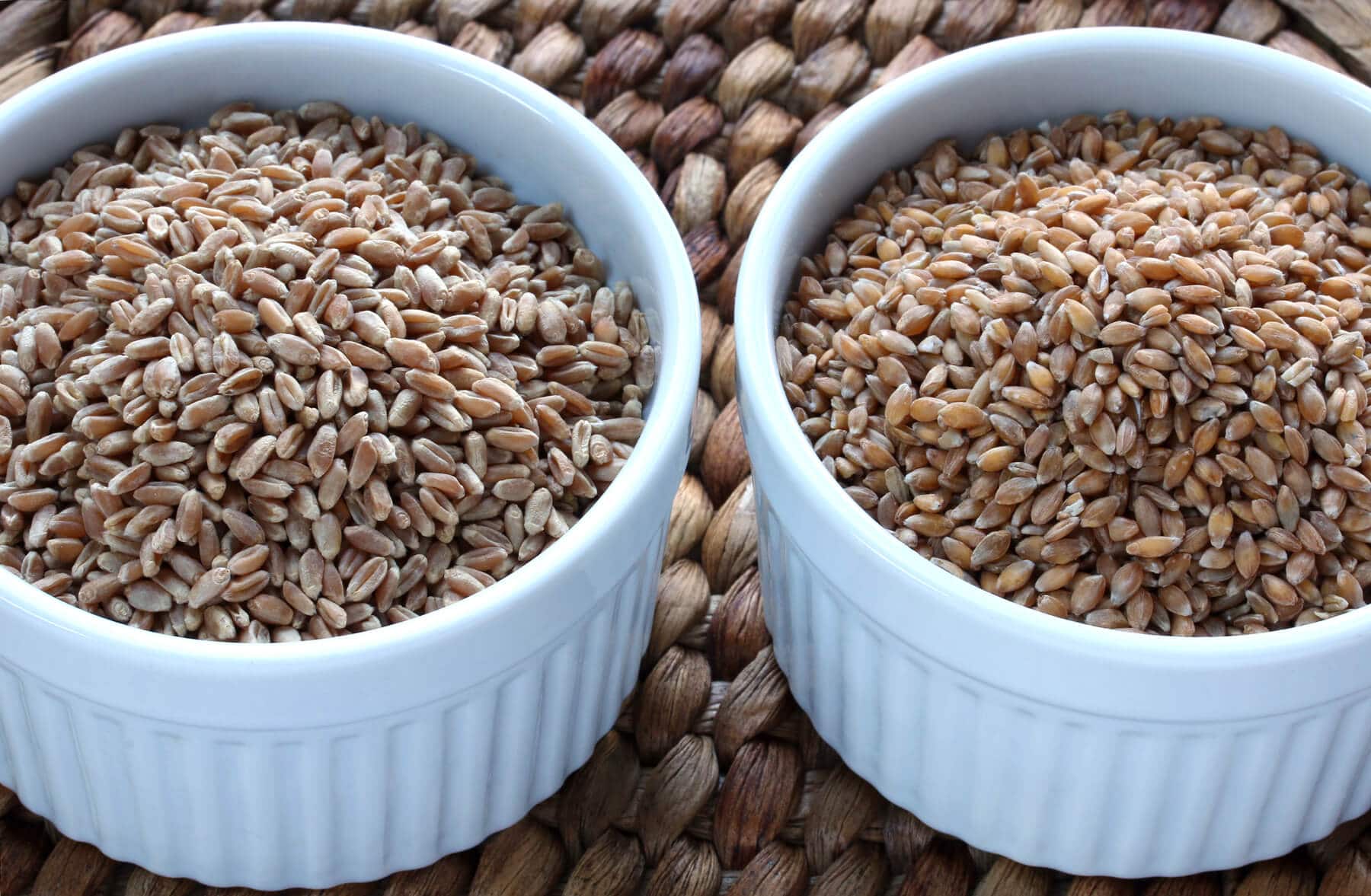
It’s unfortunate that as wonderful as Einkorn is, and common as Einkorn is in many places throughout western Europe, it’s almost unheard of here and very few places sell it. And for that reason it’s also much more expensive here in the U.S.. Hopefully that will change as it becomes more common. The same was true of spelt for a long time and though it’s still far less common than wheat here in the U.S. its price-point has gone down.
I buy all of my grains, including einkorn, in bulk. I take out what I need for a few weeks at a time and store the rest in a dark, cool place. It saves money that way and I have easy access to everything I need. And I LOVE being able to grind my own grains fresh as needed and make up my own fresh baking mixes!
My German-made KoMo grain mill is the pride and joy of my kitchen. German engineering at it’s best, the KoMo grain mill is simply awesome. You can grind your grains as fine or as coarsely as you like. With a 12-year warranty this thing is a work-horse and does a magnificent job. I use it nearly every day grinding my own flours, making cornmeal and a variety of mixes. I cannot recommend it highly enough.
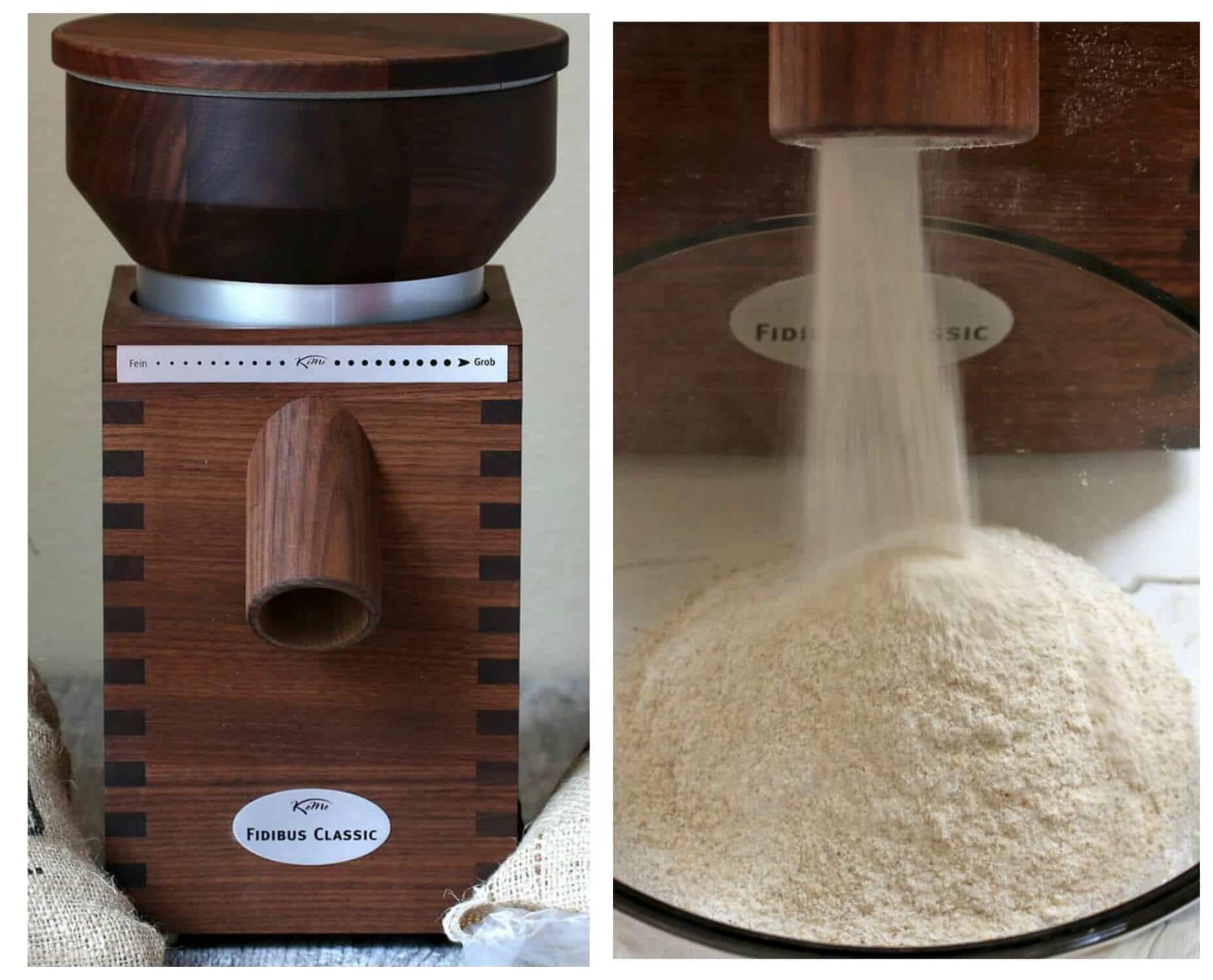
This traditional German bread uses a combination of whole einkorn berries and ground einkorn flour. Whether you’re grinding your own grains or buying the flour already ground, you’re absolutely going to love the texture and flavor of this wonderfully hearty, rustic and thoroughly authentic German bread!
German Sourdough Bread
A couple of our readers have reported back about using sourdough starter instead of yeast. To make this a sourdough Vollkornbrot omit the yeast, add 200 grams of active sourdough starter, and reduce the flour by 100 grams and the water by 100 grams. Give the batter a full 24 hour ferment.
German Bread Recipe (Vollkornbrot)
Let’s get started!
Dissolve the yeast and sugar in the lukewarm water and let sit for 5-10 minutes until frothy. (See above if you prefer to use sourdough starter.)
Place all of the dry ingredients in the bowl of a stand mixer. (You can do this by hand if you prefer.)
NOTE: I personally don’t pre-soak the whole or cracked grain berries and let my batter ferment for a full 24 hours which softens the berries. Depending on the age of the grains you’re using they may require a pre-soaking in order to be adequately soft. If you wish you can pre-soak the grains overnight (pour hot water over them and let them sit) and then thoroughly drain for an hour or so.

Add the yeast mixture along with the buttermilk and beer. Knead on the bread setting (#2) for 10 minutes.
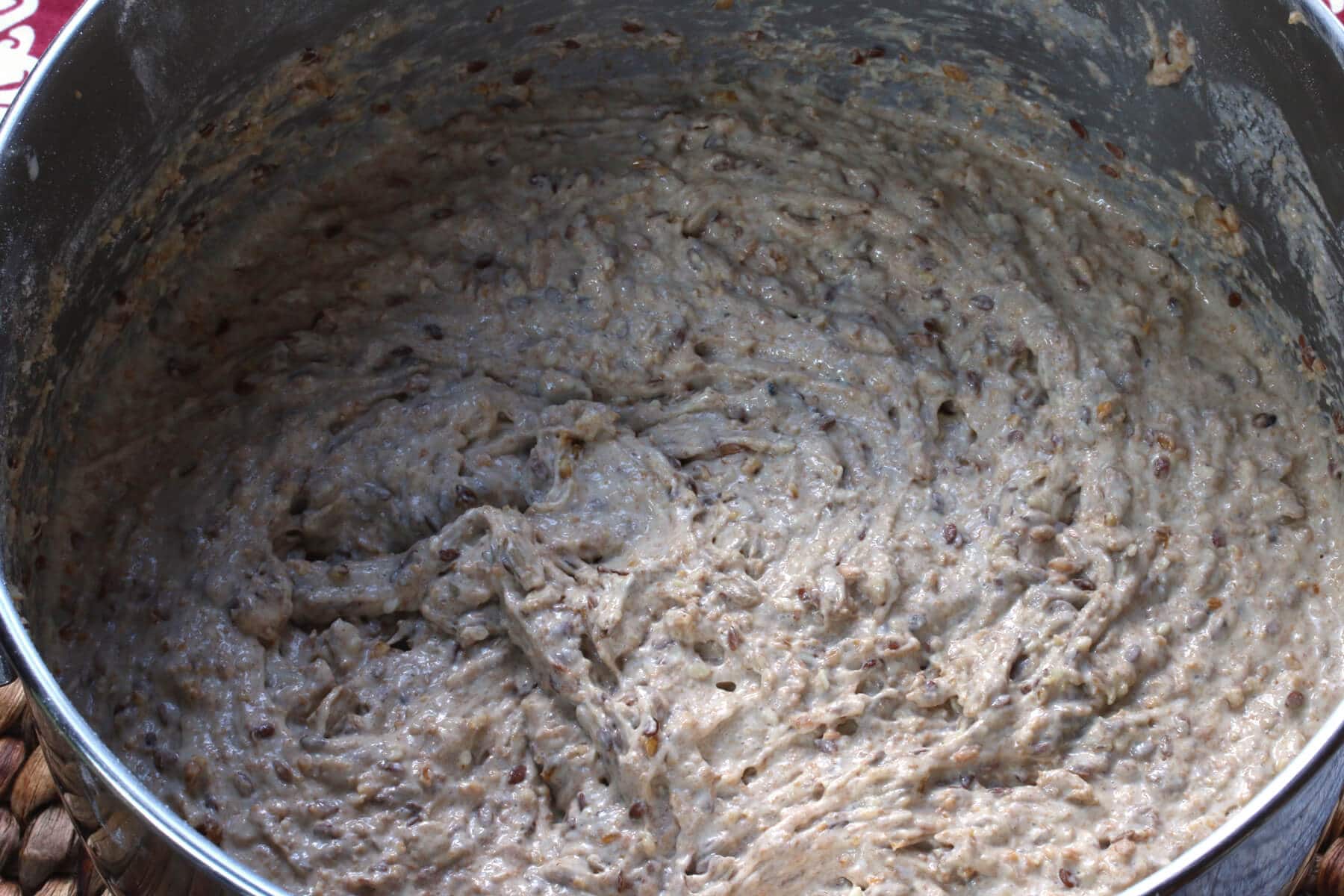
Scoop the mixture into a non-reactive bowl, cover loosely with plastic wrap and let it sit at room temperature for at least 8 hours, preferably longer, up to 24 hours (the longer the better for the whole grain berries to soften and for heightened sourdough properties. If you’re letting it sit for less than 24 hours, presoak the grains overnight in advance and drain thoroughly). Also, the longer it ferments the more liquid will be absorbed so less chances of a moist center after baking.
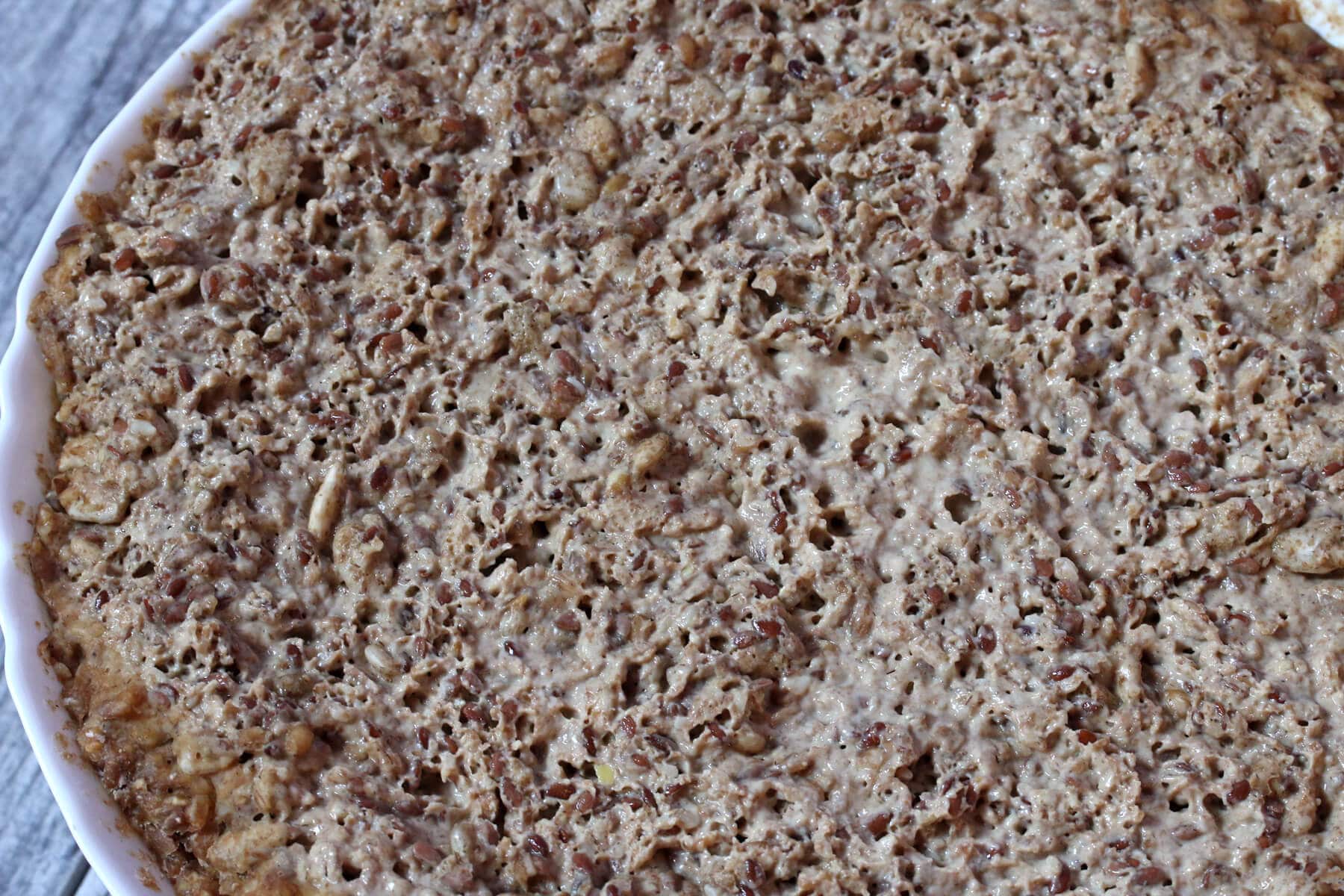
The mixture will be thick and gooey but will not resemble typical bread dough.
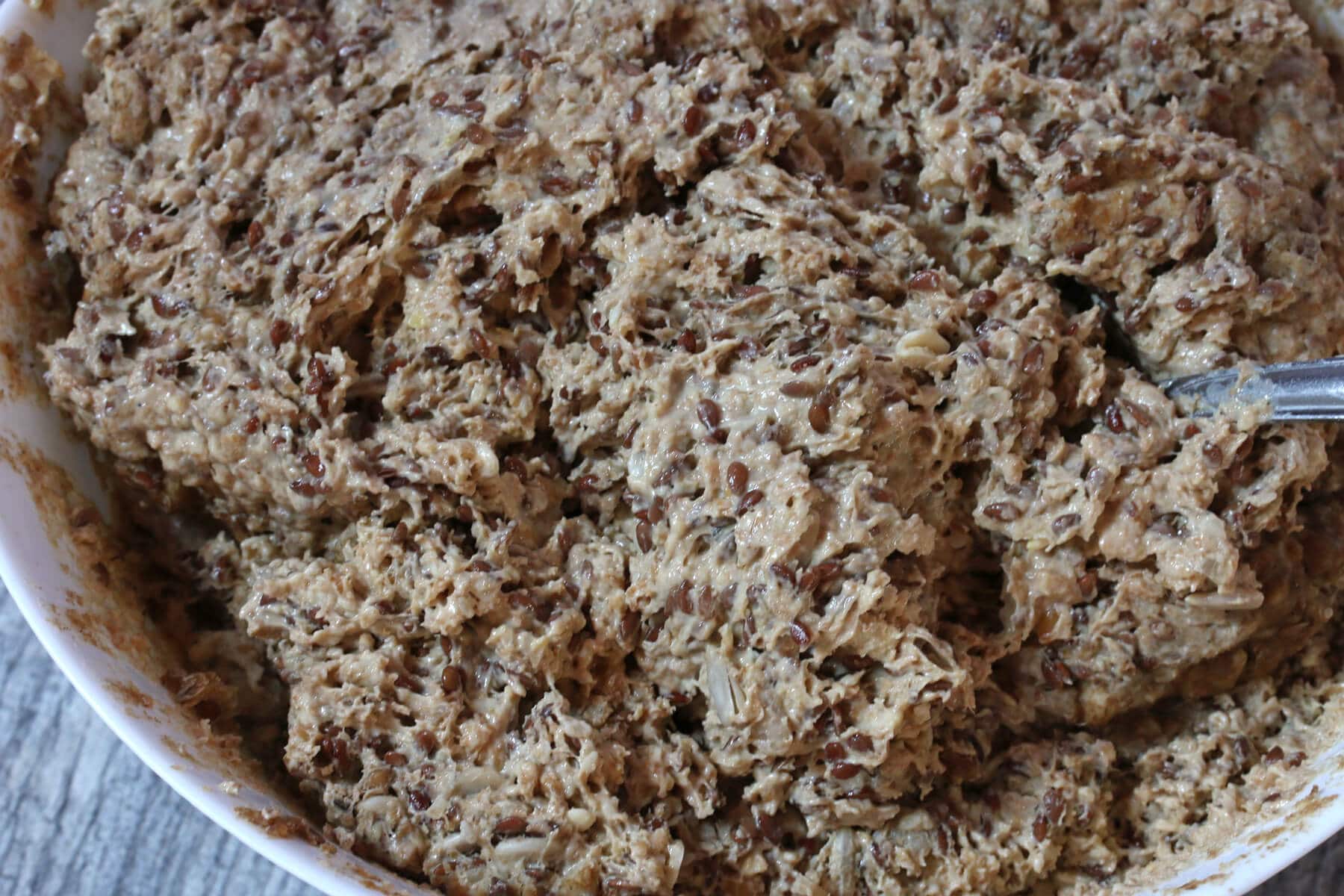
Scoop the mixture into a generously buttered Pullman Loaf Pan and smooth the top so it’s even.
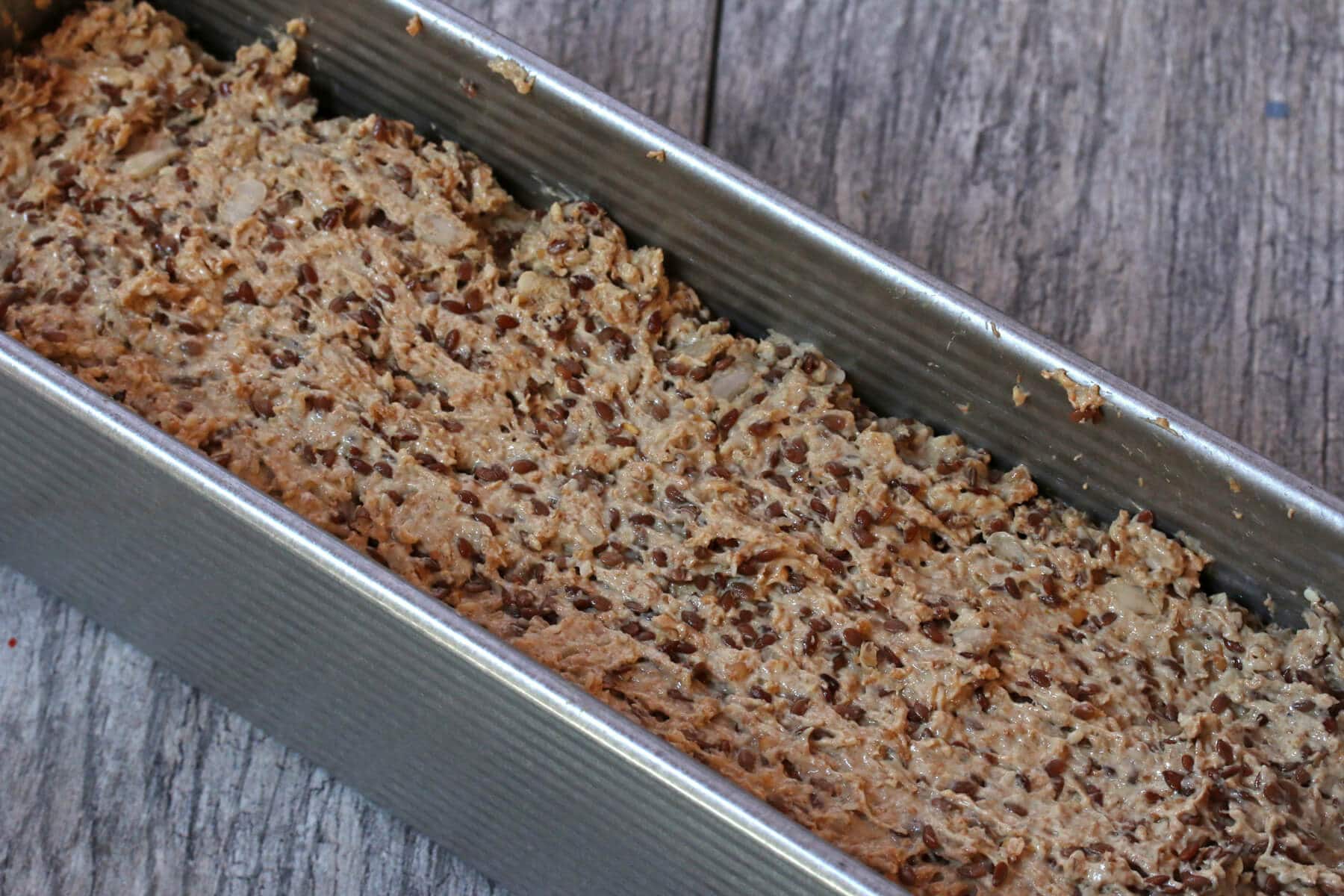
Baking this bread in a Pullman loaf pan yields those nice small, square slices of bread. But it also helps ensure that the center of the bread is fully cooked. Plus, when I’m making other breads that rise a lot, the Pullman has a top on it that slides shut to keep the bread compact (this Einkornbrot doesn’t rise a lot during baking so I don’t bother putting the lid on for it). It’s also the loaf pan that is used to make the famous French pain de mie bread. I like to use it for a lot of my heartier European style breads.
Sprinkle the top with rolled oats.
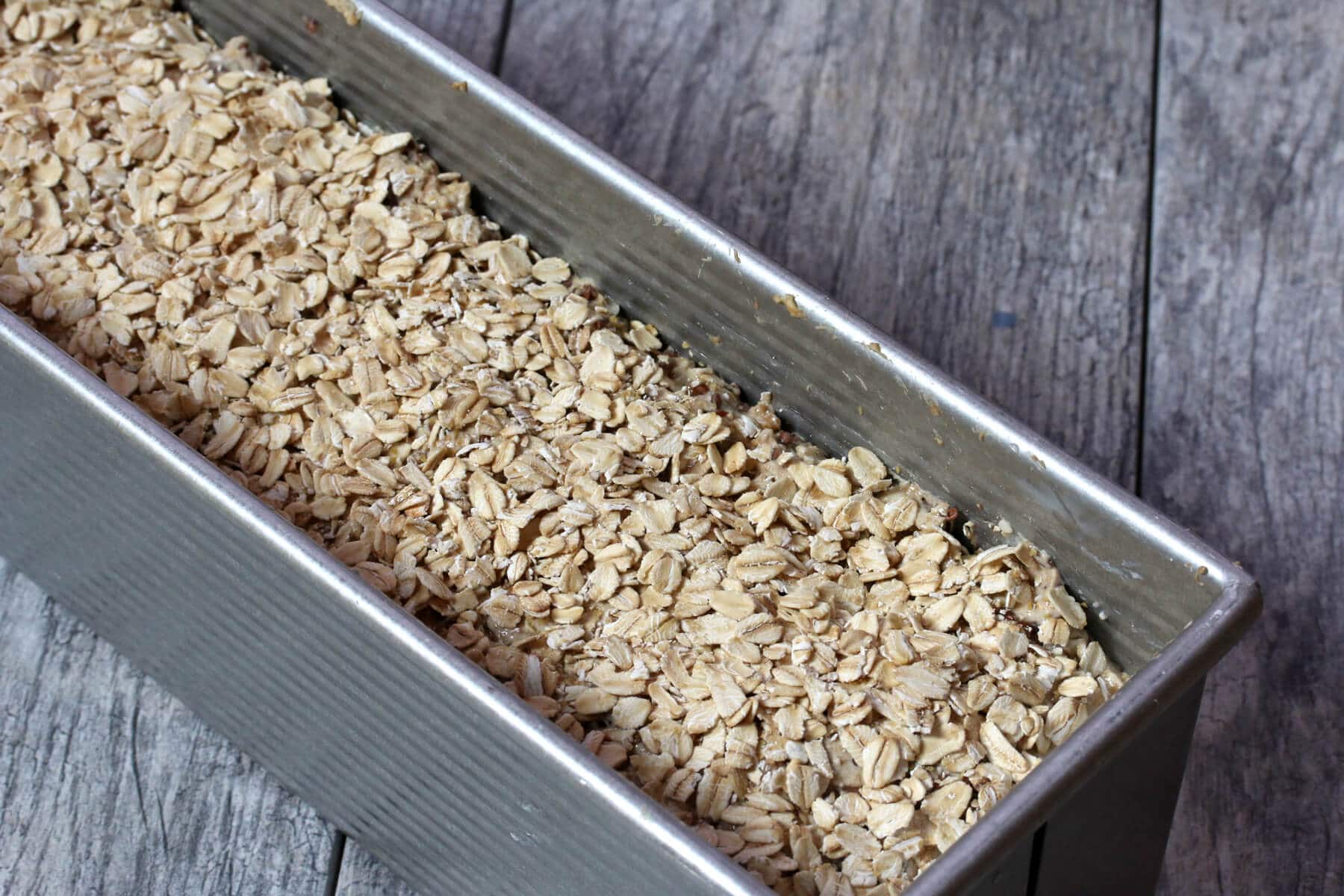
In an oven preheated to 350 degrees F, bake it on the middle rack for 100-120 minutes or until the center is done.
For best and most accurate results, use an instant read thermometer and aim for an internal temperature of 205-210 degrees F.
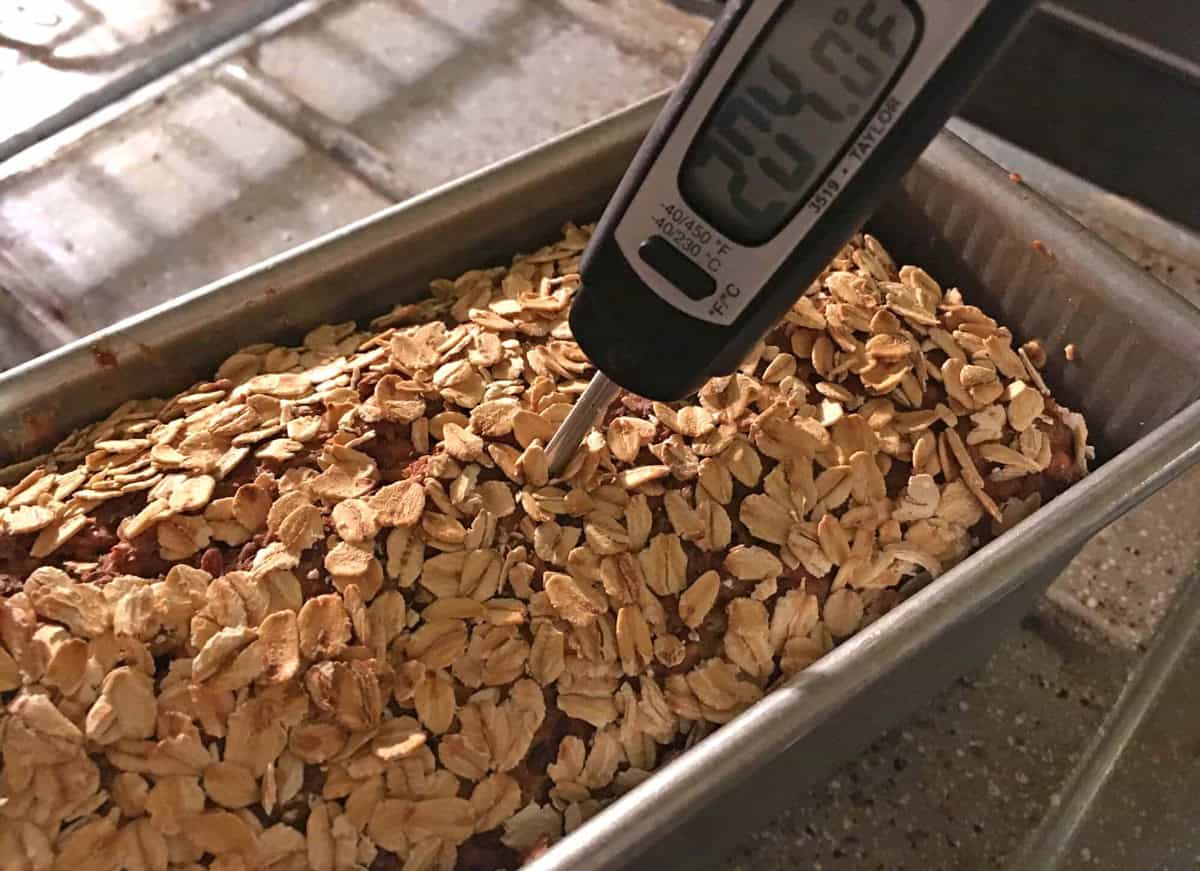
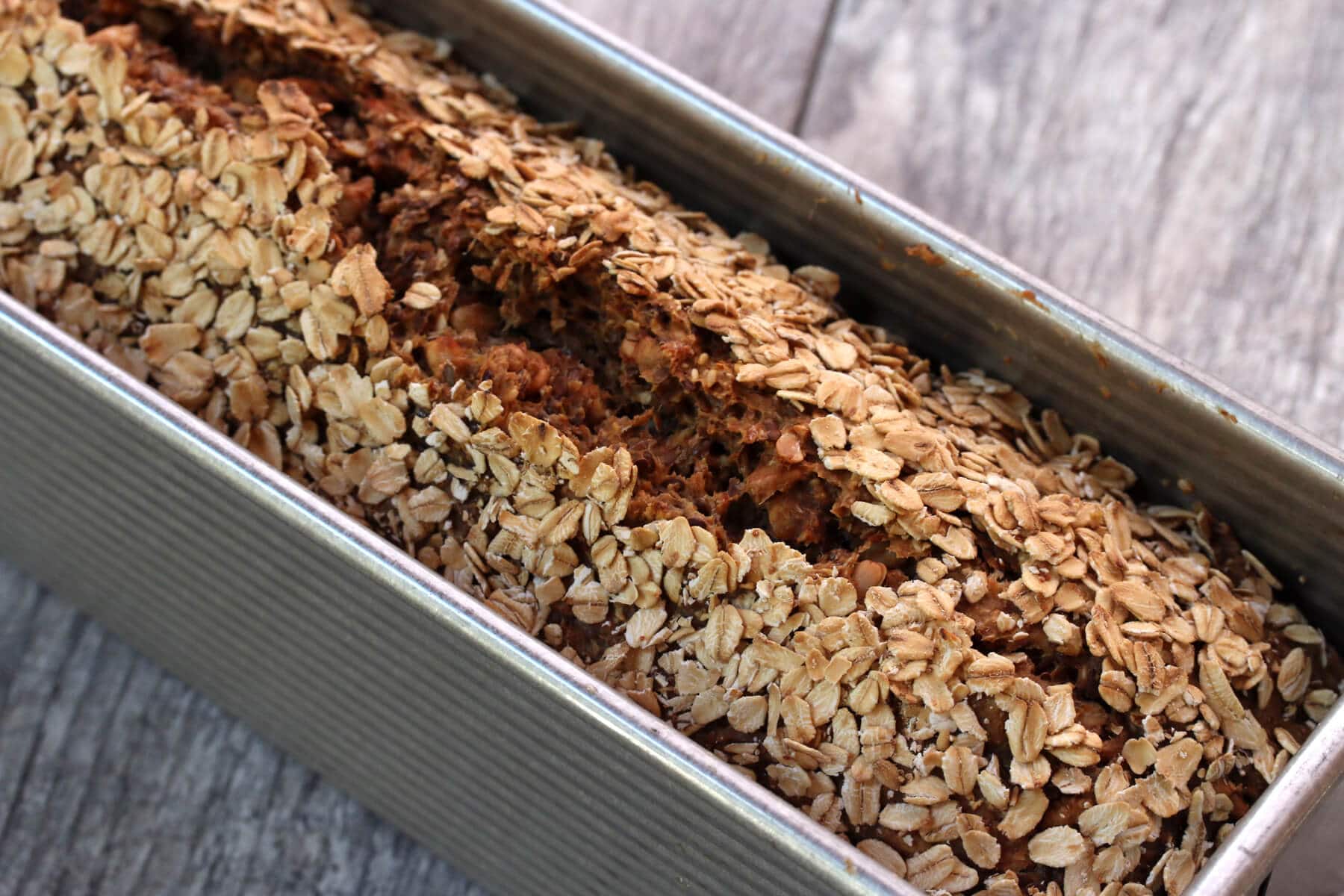
Let is sit in the pan for 5 minutes before removing it, then let it cool completely on a wire rack.
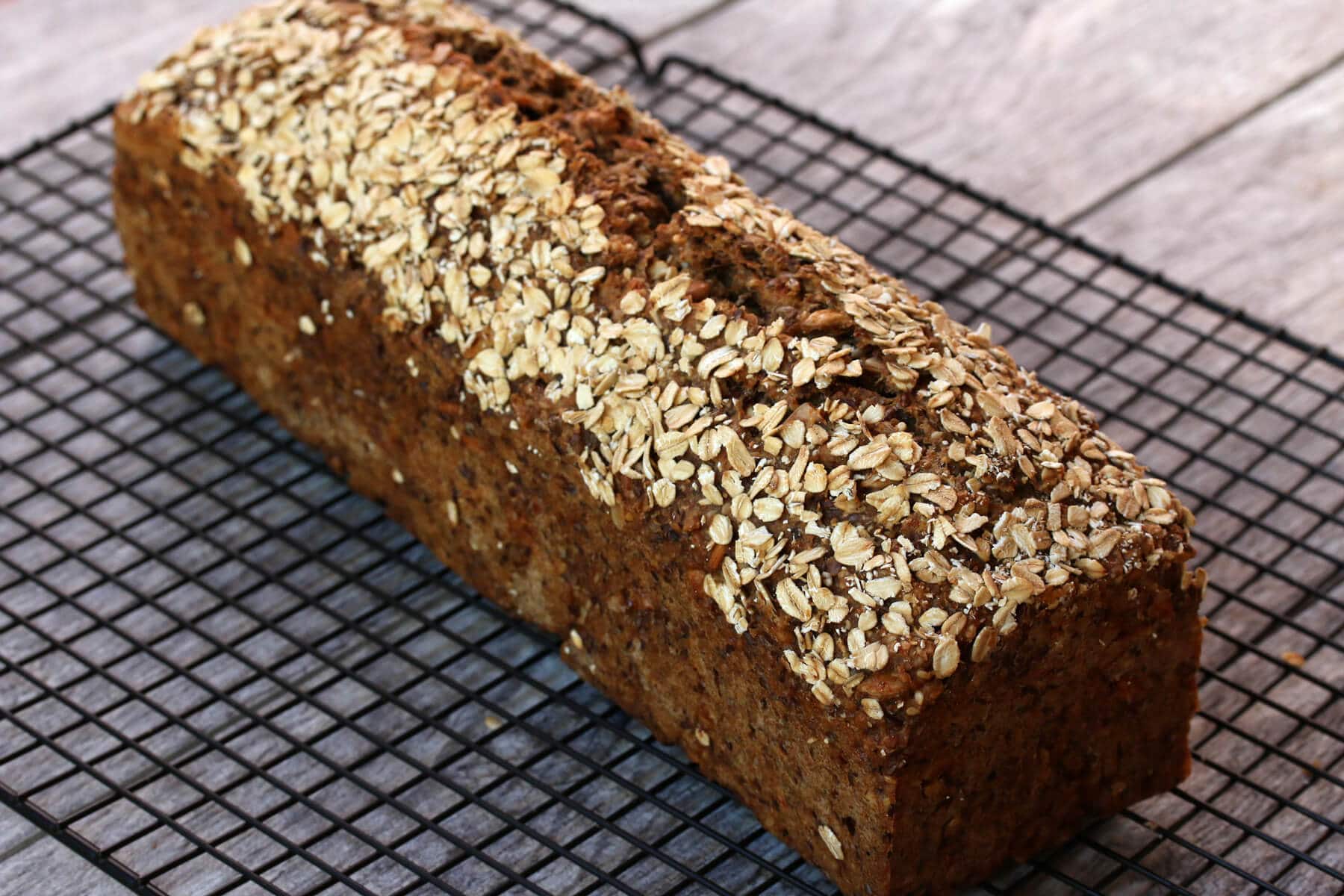
Once cooled you can slice the entire loaf in advance or slice as needed.
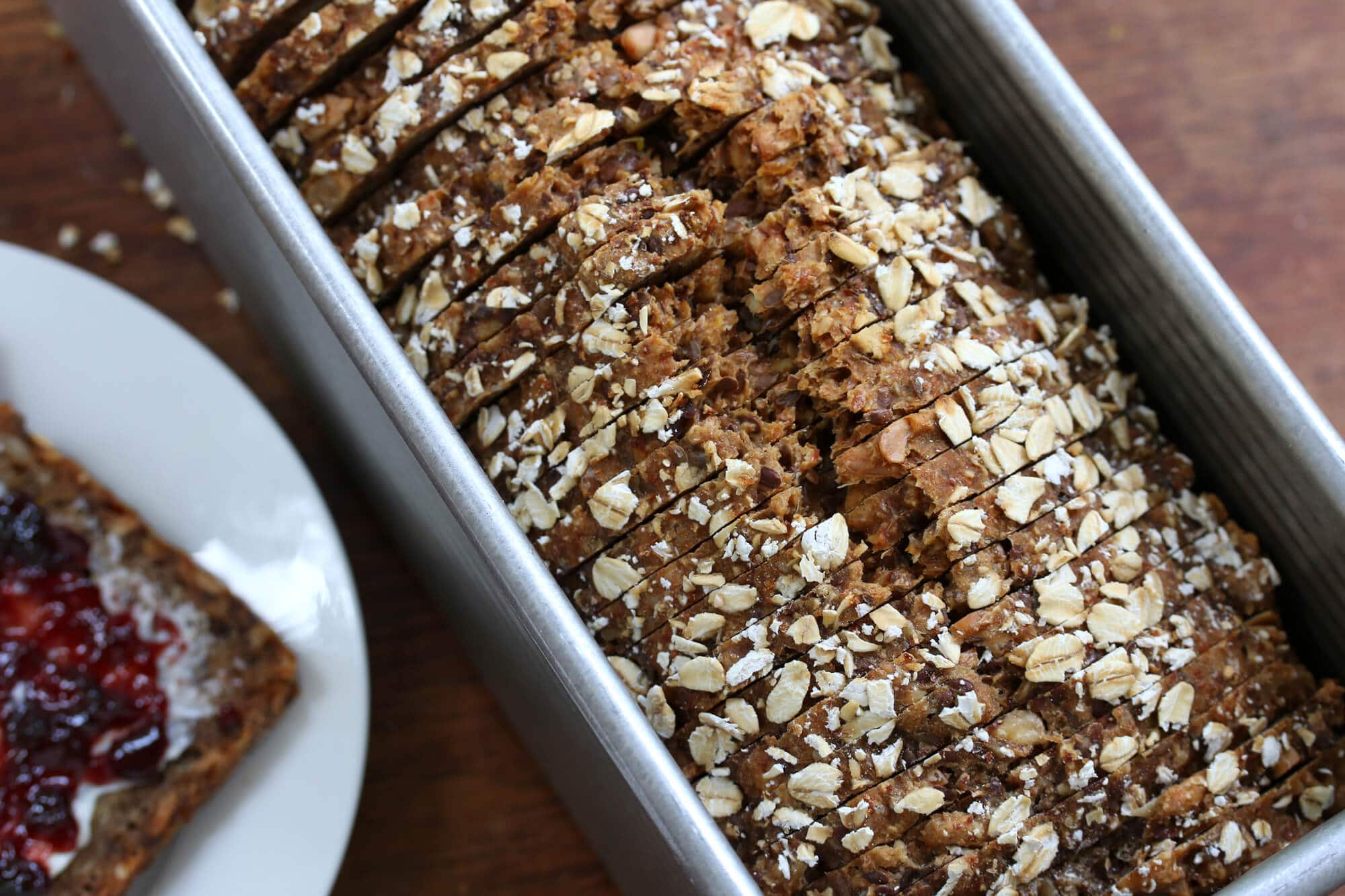
We have a decades-old Hobart commercial slicer that we picked up on Craigslist years ago. I used to be the manager of a delicatessen in England and Hobart is the gold standard in food slicers. In fact, the very same model that we have is on display at the Smithsonian!
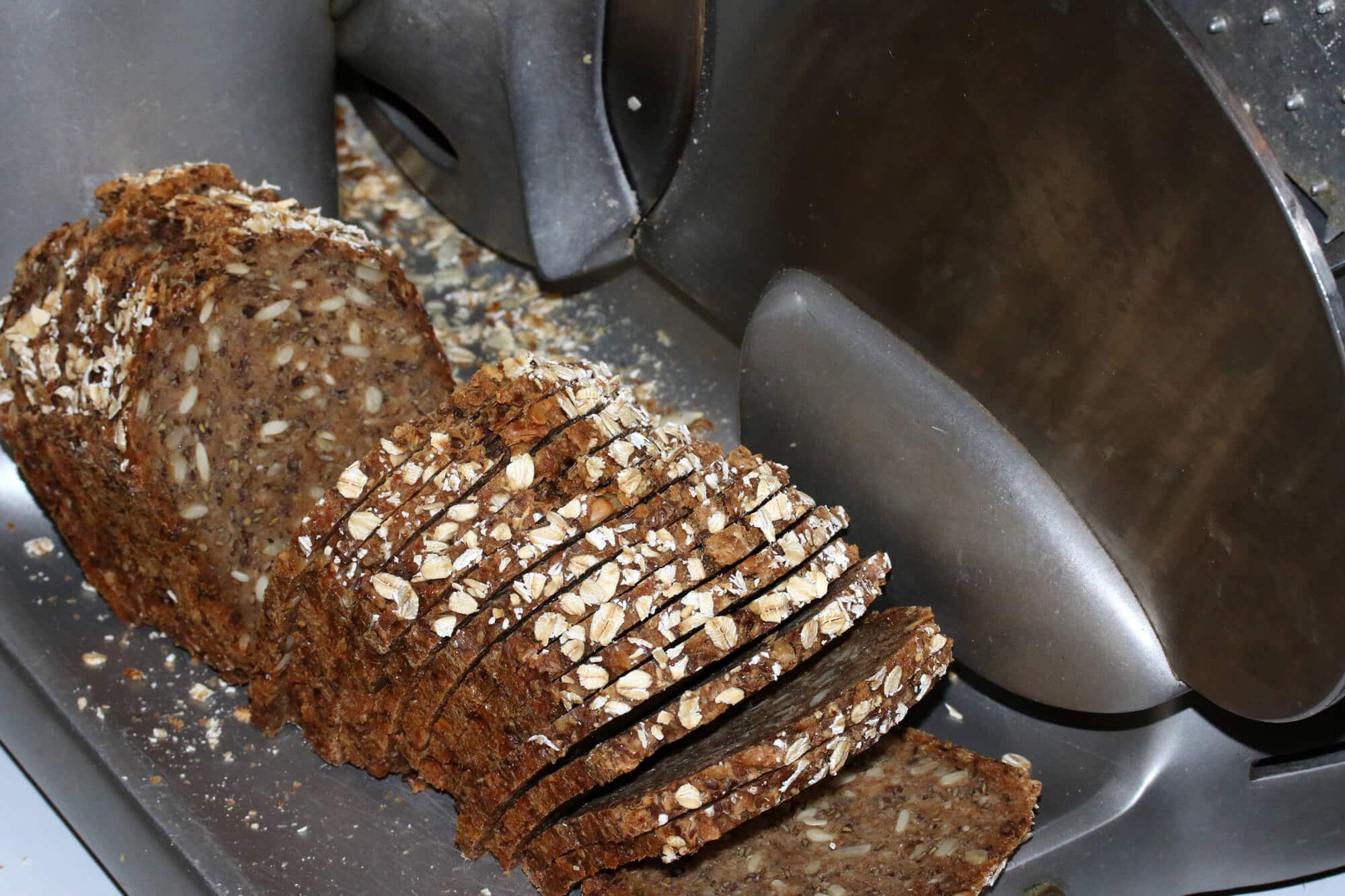
I realize we got lucky and most of you aren’t going to find a good-priced Hobart on Craigslist, but there are other good slicers on the market that are vastly cheaper and do the job. Chef’s Choice Slicers are consistently ranked at the top. I haven’t personally tried one, but they get excellent reviews. Having a good slicer to get clean, thin slices of bread that look like something you bought at a professional bakery is really nice. Plus, whenever I find chunks of cooked ham, turkey or cheese on sale I get those and slice them myself – it’s much cheaper than buying them at the deli.
At the very least you’ll need an excellent bread knife and for that my favorite knife, hands down, is the Cutco 9 3/4″ Slicer. It glides smoothly through bread and meat like no other.
Enjoy!

For more delicious bread from around the world be sure to try my:
- Lavash
- Injera
- Dosa
- Sourdough Naan
- Danish Rye Bread
- Crumpets
- Olive Rosemary Focaccia
- Skillet Cornbread
Save This Recipe
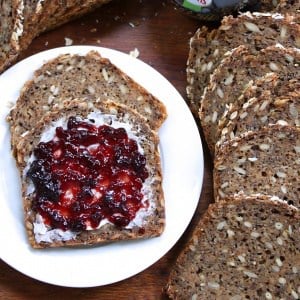
German Bread (Authentic Vollkornbrot)
Ingredients
- 4 1/2 cups einkorn flour (you can also use whole wheat, spelt, rye or combination)
- 1/2 cup whole einkorn berries , or wheat, spelt or rye berries (***See NOTE about soaking)
- 1 3/4 cups cracked einkorn berries , or wheat, spelt, rye (**See NOTE about cracking the grains **See NOTE about soaking)
- 1 cup whole flax seeds
- 1 1/2 cups sunflower seeds
- 1/4 cup sesame seeds
- 3 teaspoons salt
- 2 teaspoons dry active yeast ** see Note for sourdough substitution
- 2 tablespoons sugar , optional but recommended
- 2 cups lukewarm water
- 2 cups buttermilk , at room temperature
- 1 cup mild beer (optional, for a maltier flavor) , at room temperature (can substitute water or buttermilk instead)
- Rolled oats for sprinkling
Instructions
- Dissolve the yeast and sugar in the lukewarm water and let it sit for 5-10 minutes until frothy.
- Combine all of the dry ingredients in the bowl of a stand mixer. (You can do this by hand if you prefer.) Then add the yeast mixture along with the buttermilk and beer. Attach the dough hook and knead on the bread setting (#2) for 10 minutes. Scoop the batter into a large non-reactive bowl, cover loosely with plastic wrap, and let it sit at room temperature for at least 8 hours, preferably longer, up to 24 hours (the longer the better for the whole grain berries to soften and for heightened sourdough properties. Also the longer it ferments the more liquid will be absorbed so less chances of a moist center after baking.)
- Preheat the oven to 350 degrees F.
- Scoop the batter (it will be thick and gooey but not like regular bread dough) into a generously buttered 13x4x4 Pullman loaf pan and smooth the top to even it out. Sprinkle with oats. (Note: Baking this bread in a Pullman loaf pan yields those nice small, square slices of bread. But it also helps ensure that the center of the bread is fully cooked.) I always bake this without the lid on.
- Bake on the middle rack for 100-120 minutes or until the center is done. For best and most accurate results use an instant read thermometer and aim for 210 degrees F. Let the bread sit in the pan for 5 minutes before removing it, then let it cool completely on a wire rack before slicing it. To get clean, professional slices I highly recommend using a bread slicer.
Notes
- How to “crack” the whole berries: I use my grain mill to crack them by putting it on the coarsest setting. Another option is if you have a Vitamix and use the dry container – pulse the whole berries a few times until you get coarse pieces of einkorn. A powerful food processor will likewise do the job. Alternatively you can also place the whole berries in a ziplock bag and use a heavy object to pound them to break them up.
- Soaking the Grains: I personally don’t pre-soak the whole or cracked grain berries and just let my batter ferment for a full 24 hours which softens the berries, and I’ve always had great results. However, depending on the age of the grains you’re using (even if you just bought them they may have sat in the store or warehouse for a long time) they may require a pre-soaking in order to be adequately soft. If you wish you can pre-soak the grains overnight (pour hot water over them and let them sit) and then thoroughly draining.
- **Sourdough Substitution: To make this a sourdough Vollkornbrot omit the yeast, add 200 grams of active sourdough starter, and reduce the flour by 100 grams and the water by 100 grams. Give the batter a full 24 hour ferment.
Nutrition
Originally published on The Daring Gourmet December 11, 2019



















Hello!
I am really looking forward to trying this recipe, however, I do not have a pullman loaf pan. Do you think it would work to separate the dough into two 1-lb loaf pans (8.5 x 4.5 x 2.75)?
Hi Lezlee, it’s too much dough for one 1-lb loaf pan and is probably not quite enough for two 1-lb loaf pans. The second loaf pan may need to be smaller, you’ll have to eyeball it when you’re filling your pans.
Thank you for the quick response! I will try that, and maybe I’ll just invest in the pullman pan anyway :)
I’d like to know how much of the 13x4x4 pan you use is filled with this dough quantity. Thinking I needed to reduce it by about factor .65 for an 8.5x4x4 pan (8.5/13=.65) I had too much dough, but also read you instructions wrong thinking that you filled it to the top (“smooth the top”, I guess I’m getting senile) and so after proofing cold overnight (you don’t proof, so not even sure why I did this either!) I had a mess. I trimmed it up and baked it anyway, and got a muffin top like crust all around but the main body looks like its going to work. Going to let it sit 24 hrs before slicing. The other thing is that I just couldn’t bring myself to NOT soaking, so I used some of the liquid quantities in the soakers, and just added water till I had a rather thick batter/dough. Like peanut butter maybe. Seems to have worked.
I need to edit this too, to say that I also used some flour and liquid to replace with a sourdough starter, and eliminated the buttermilk. So I really altered this to the point where the original recipe was a starting point for me to get a rough idea of proportions. Any failings were my own, not the recipe’s.
I made this bread Thursday and it is so good! I waited and ordered the pullman and even though it is very hot in the Caribbean, I waited until about 6:00pm to make the dough and did not soak the berries as we discussed. I let it ferment about 22 hours and popped it in the oven and it turned out great. My husband loves it and it has been great to make sandwiches which I rarely do as I don’t eat modern day wheat if I can help it.
Thank you, Cathy, I’m so happy you both enjoyed it!
I have to add my appreciation for this recipe. My husband and I spent some time in Switzerland a couple of years ago and I wanted to reproduce the rye vollkornbrot we ate there. I found your recipe, bought the Pullman pan, rye berries, and a vintage grain mill (a Magic Mill from the 80s) and boom, perfect! I have since moved to sourdough for the recipe instead of beer and buttermilk, and made a few other modifications, but it is based on your proportions. I bake it about every two weeks and we have it toasted for breakfast every morning. I don’t eat meat and the complex flavor and dense texture satisfies that “umami” craving. Every couple of days my husband says “the toast is SO good.” It’s been a great success, so thank you very much!
I’m so happy you’ve both been enjoying this, Lee, thank you!
Hi Kimberly. Great recipe. I am on my second batch now. The second batch is now at about 18 hours after mixing and is wonderfully foamy, from fermentation. I wondered what is the reason to have the soaking/fermenting happening in a mixing bowl – and not in the oven pan? Is it because of reaction of the mix with the metal of the oven pan? The reason for asking is the transfer to the oven pan before baking causes the nice foaminess of the mixture to collapse, especially if we get heavy handed with smooshing the mix in to the corners of the pan to make a nicely formed loaf. So the transfer seems to lead to a heavier and less aerated loaf. Obviously it still works and tastes great, but just curious thats all.
Thank you, Mike, I’m happy it’s been a success! That’s a good question. As long as the loaf pan you’re using is stainless steel then there’s no issues with the ingredients reacting with the metal, otherwise yes, that would be a problem. But the possible problems go beyond that. This kind of bread is supposed to be dense and it shouldn’t have air pockets like regular soft bread does. Its ability to hold together relies on its “denseness” and so transferring the batter into the loaf pan and allowing it to collapse serves an important function. Now, this is speaking theoretically and I haven’t actually verified that the texture will be compromised if you don’t deflate the batter, so if you decide to experiment with that please let us know how it goes!
there’s no final proofing stage either, so if you think its too dense, maybe try letting it proof a bit before baking, but I’ve never had an “airy” volkorn anything (einkorn, rye spelt).
I am so excited to find your we site! I found I have an intolerance to gluten, but can eat einkorn. I don’t have the pullman pan, but do have a gran mill and einkorn berries, so I will cut the recipe in half and try a regular bread pan. The only concern I have is the heat in the Caribbean. Evenings are coolish, but can get to 90 F in my kitchen easily, but assuming if I let the batter sit for 24 hours in our warmth, it will just taste a bit more sour?
I’m glad you found my site too, Cathy! :) Yes, it will ferment much faster at that temperature. I would recommend a shorter fermentation time but pre-soak the einkorn berries (see the note at the bottom of the recipe “Soaking the Grains.” I would start the ferment in the evening and let it ferment overnight (since the evenings are cooler) – so 12 hours or so. If the dough is already a little puffy/bubbly (see my pics) by the morning go ahead and proceed with baking. If it isn’t, let it ferment a little longer but keep an eye on it. Happy baking and please let us know how it goes!
Thank you so much for this wonderful recipe! I’ve tried it a few times and it’s turned out perfectly. However, I was wondering if anyone has tried to substitute sourdough starter for commercial yeast in the recipe and what adjustments would need to be made? Thank you!
Thank you, Lena, I’m so glad you enjoyed it! If I’m remembering right it seems another reader or two left a comment about substituting sourdough starter (it was either for this recipe or the Danish Rye Bread). Let’s see if someone who’s used sourdough starter can chime in and offer some tips.
Hello: I’m brand new to baking let alone this type of recipe. I love this type of bread so I was super excited to try it. But, I’m not sure if I got the right result. It *looks* perfect and as expected. But the taste….. is a wee bit funky.
Question: Is it supposed to have a discernable sour or “fermenty” taste? I understand the proofing stage and what is happening. But I guess I thought the stronger fermented taste would largely bake off in the long hot cooking timeframe. When compared to commercial brands (Mestemacher and Trader Joe’s “European” bread) it is a WAY stronger fermenty/sour flavor. Did I do something wrong?
Hi Bea, the fermented/sour taste is directly related to how long you let the batter sit and at what temperature (the higher the temperature, the faster it will ferment and the stronger the flavor will be). So you can adjust the flavor outcome accordingly. Also, keep in mind that the store-bought breads are not truly fermented at all, so they will taste different anyway. Lastly, if you used beer instead of water or buttermilk, that may also contribute to the flavor you didn’t care for.
Hi Bea, the fermented/sour flavor is directly related to how long you ferment the batter (the longer, the stronger the flavor) and at what temperature (the higher the temperature the faster it ferments and the stronger the flavor). So you can adjust the fermented flavor accordingly. If you used beer instead of water or buttermilk that also could have contributed to the flavor you don’t care for. Keep in mind also that the store-bought breads are not truly fermented, so homemade is going to taste different anyway.
I make this bread every other week and I use beer and buttermilk and ferment for 24 hours. The batter/dough has a very ‘beer-y’ smell and there is a definite sour taste profile from the fermentation and it is a characteristic of every loaf that I have made – which I love. I also added a tablespoon of Brotgewürz or German Bread spices (anise seed, caraway seed, coriander seed and fennel seed ground into a powder) to the bread which makes it taste so authentic to me. Nothing at all against Mastemacher, Trader Joe’s or other commercial breads but they do not have a fermented taste at all – to me. It sounds like you did everything right in this recipe, maybe ferment it less if you don’t like the taste?
Thank you for this recipe. I weigh ingredients when baking whenever I can and I ended up not using about 500 mls of liquid. I used einkorn flour and followed the other dry ingredients as written. I didn’t pre-soak any of the grains. I just didn’t need so much liquid. The bread turned out great after 24 hours of soaking.
Excellent tasting bread – very authentic! Recipe was clear and easy to follow. It came out perfectly without any modifications needed.
Fantastic, Paul, thanks so much!
Hi Kimberly, thank you for this recipe, I make a double batch, makes three loaves, because it stays fresh for so long. I do share at least 1 loaf every time I bake, which is at minimum once a week, because of high demand, especially from friends with northern European backgrounds. I use “normal” silicone bread pans and find that it takes an extra 20 minutes even in a convection oven. I also have and love the Komo mill and mine has a flaker attached to it, so I can even make my own Oat flakes to top the loaves. I get organic, and in some cases heritage, grain from Fieldstone Organics in Armstrong, British Columbia. Yummy!
That’s wonderful, Rina, I’m so glad it’s been a hit and appreciate the feedback, thank you!
Hi. I’m excited to make this bread, but I’m having trouble. My yeast hasn’t risen much.after I added it to the dry elements. I’ve read that I should throw it out. Is there anyway I can save all those ingredients? Stir in a new yeast?
Thanks.
Hi Robin, this batter is not going to rise like regular breads, that’s totally normal. Just let the batter rest as directed and bake it.
Thank you for this recipe! I’m German and in my opinion the bread tastes very authentic :) I’d only baked sourdough bread before and this recipe was super easy to follow. Didn’t add beer beer I used a cup of boiling water to pre-soak the grains for an hour or so. I also used whole farro grains instead of einkorn kernels because that’s all I could find (tip: whole foods had the farro grains in the soup section along with dried peas and lentils, NOT in the flour section).
I let the dough ferment for about 14 hours and then baked it in two 9-inch loaf pans for 2 hours. The internal temperature never went above 200 degrees but the center was still perfect.
Thank you so much for your feedback, Miriam, I’m thrilled you enjoyed it!
Kimberly, The bread is wonderful but mine came out too wet. I followed your instructions to the letter including the 24 hour fermentation, all fresh ingredients including the einkorn flour, and even bought a loaf pan. Thoughts?
Thank you for a wonderful website. I’m so glad to have discovered you. I was raised by mom and Omi, both born in Stuttgart. Bavarian food rocks!
Thank you so much, Edward! Did you use an instant read thermometer to check the bread for doneness? I can’t recommend that strongly enough.
Hi Kimberly, I have a wetter dough as well. I am not sure if this is normal but I did an instant read thermometer to 205F and it is still quite moist after letting it cool over night and cutting into it the next morning. I have had bread like this and love it but it is my first time making it. It there any moisture left after baking or should it be completely dry?
Hi Jennifer, a little moist is normal, yes, as long as it isn’t “wet”.
Thank you for sharing your wonderful recipe! I’m new to einkorn flour and fermented bread but a pretty experienced sourdough/bread baker. I did measure the flour by scoops after reading a comment that alerted me to that possibly being an issue. Just out of curiosity I compared the weight of what the package said 4.5 cups would weigh with what my actual scoops of flour weighted and it was very different (i.e. 432g vs 584g). I went with the 584g and it worked beautifully. I fermented it a full 24 hrs. I did use barley syrup instead of sugar and a Belgium blond beer and was pleased with the flavor – although it isn’t quite as dark as your bread. I used the pullman pan you recommended and baked it on top of a baking stone for 125 minutes total (it was at 203.5 F at 120 minutes so I popped it back for another 5 minutes and it rose to 206.6F). My husband and I have just enjoyed a slice and I can’t wait to try more of your recipes!!!!
Thank you so much for that feedback, Claudia, I’m so glad you and your husband enjoyed this!
I lived in Germany for two years and fell in love with this bread for Abendbrot. My question is this, since I DO NOT use baker’s or instant yeast, how can I make this using a sourdough start?
My husband had volkornbrot from a local bakery and fell in love with it! He read more about it and learned it was traditionally made with einkorn, which our local bakery didn’t use. He had me intrigued and I found your recipe and we ended up investing in the baking pan and multiple bags of einkorn flour and einkorn berries… thankfully it was money well spent and my husband says our homemade loaves are better than the one we purchased. I’ve added pumpkin seeds, flax seeds, ground flax – depending on what we had on hand – and started adding oats to my dough to absorb some of the moisture when it seemed “too wet”. (I started weighing my einkorn flour and have found my dough seems wetter than when I used measuring cups.) in any event – this recipe does well with substitutions and we’ve loved all our variations. Thanks for your wonderful recipe!
I’m absolutely thrilled to hear that, Suzanne, thank you so much for the feedback! For the weighed amount, did you use the metric conversion in my recipe card (to the right of the ingredients there’s a “US Customary” and a “Metric” button)? The conversion software indicates 575 grams of flour. Is that what you used?